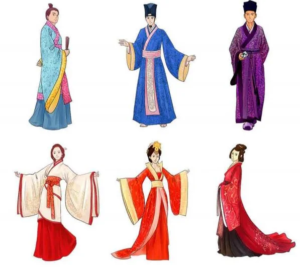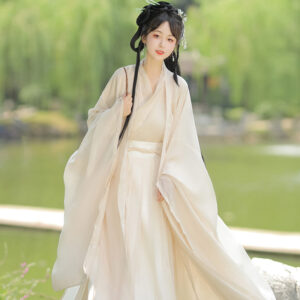

The Ruqun (襦裙) is a traditional Chinese attire that consists of a blouse (ru) and a skirt (qun). Its historical origins can be traced back to ancient China, where it evolved through various dynasties, reflecting cultural, social, and aesthetic changes. Here’s an overview of its development:
1. Early Beginnings
- Shang and Zhou Dynasties (c. 1600-256 BCE): The roots of the Ruqun style can be traced back to these early dynasties. During this period, clothing began to unify across regions, and the basic structure of a blouse and skirt emerged. The Ruqun symbolized elegance and simplicity, becoming a standard for women’s attire.
- Cultural Significance: The attire reflected social hierarchies and norms, with variations in color and fabric indicating the wearer’s status. Silk was often reserved for the elite, while commoners typically wore hemp or cotton.
2. Development in the Han Dynasty (206 BCE – 220 CE)
- Formalization of Style: The Ruqun became prominent during the Han Dynasty, where it was commonly worn by both elite and ordinary women. The design featured a cross-collared blouse tucked into a skirt, which became emblematic of Han women’s clothing.
- Material and Design: Women of higher social standing wore Ruqun made from luxurious silk, while commoners opted for simpler fabrics. The skirts were often pleated or gathered at the waist to allow for graceful movement.
3. Influence from the Silk Road
- Cultural Exchange: The opening of the Silk Road during the Han Dynasty introduced new materials, colors, and styles to Chinese fashion. This influx enriched Ruqun designs with intricate embroideries and diverse color palettes that reflected China’s growing prosperity.
4. Evolution in Subsequent Dynasties
- Tang Dynasty (618-907): The Tang Dynasty marked a high point in the evolution of Ruqun. With increased cultural exchanges due to trade and diplomacy, Ruqun styles became more elaborate, featuring wider sleeves and more decorative elements. This era also saw some gender fluidity in clothing styles.
- Song Dynasty (960-1279): During this period, the focus shifted towards modesty and simplicity, leading to more tailored designs that adhered to Confucian ideals.
5. Continued Popularity through Later Dynasties
- Ming (1368-1644) and Qing Dynasties (1644-1912): The Ruqun continued to be worn throughout these periods, adapting to changing societal norms while maintaining its core elements. During the Qing Dynasty, Manchu influences began to reshape traditional styles but did not completely replace the Ruqun.
Conclusion
The Ruqun style has deep historical roots in Chinese culture, evolving from its early forms in the Shang and Zhou dynasties through various dynastic influences that shaped its design and significance. Its enduring popularity reflects its adaptability and cultural resonance as a symbol of femininity, grace, and traditional aesthetics within Chinese heritage. The Ruqun remains a cherished component of Hanfu fashion today, embodying centuries of history and cultural expression.
Share this post
Recent Posts


What were the key features of Hanfu during the Tang Dynasty?

How did Hanfu styles vary during different Chinese dynasties?

What accessories are typically worn with Hanfu?

How do you choose the right Hanfu for different seasons?

Newsletter
Popular Categories
Related Post
Sed aliquam, tortor et sodales malesuada, lorem leo luctus tellus, quis interdum eros nibh in nunc. Cras dignissim malesuada, lorem leo luctus

What are the winter hanfu called?

What were the key features of Hanfu during the Tang Dynasty?

How did Hanfu styles vary during different Chinese dynasties?


